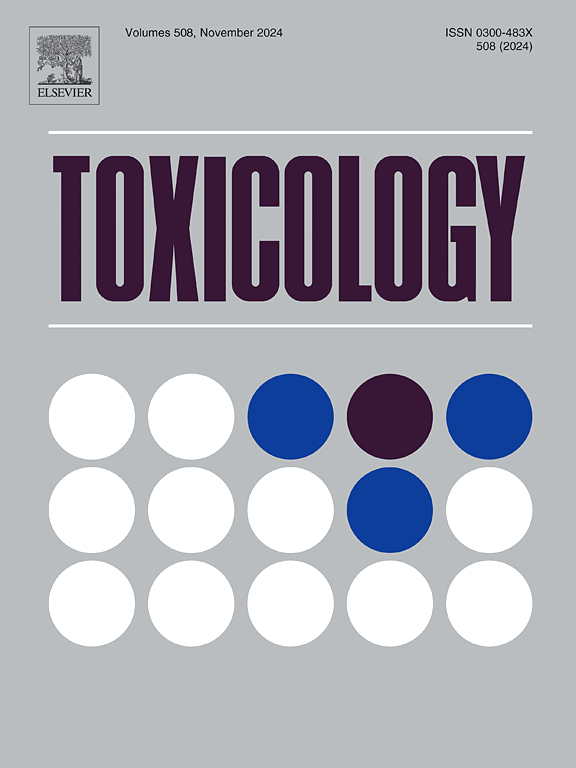暴露于生物质燃烧污染混合物中的肝细胞的代谢组学和氧化还原变化因脂肪酸诱导的NAFLD而异。
IF 4.6
3区 医学
Q1 PHARMACOLOGY & PHARMACY
引用次数: 0
摘要
生物质燃烧(BB)是大气污染物的一个重要来源,产生木焦油(WT)颗粒,构成构成健康风险的碳质气溶胶的相当大一部分。在这些健康风险中,非酒精性脂肪性肝病(NAFLD)是一种在世界范围内广泛传播的疾病。本研究使用非靶向代谢组学和功能分析来研究预先存在的代谢状况(如NAFLD)如何影响肝细胞对BB暴露的反应。将人HepG2细胞与月桂酸(LA)(饱和脂肪酸(FA))或油酸(OA)(不饱和脂肪酸)预孵育,以模拟NAFLD条件,然后暴露于水溶性WT (WS-WT) (BB衍生的混合物)。我们的研究结果表明,OA预孵育比单独的LA预孵育更显著地改变了代谢物谱,并且在WS-WT暴露后通过预处理观察到显著不同的代谢组学改变。此外,OA预孵育对WS-WT暴露的保护作用比LA更强。代谢组学分析显示,oa预孵育的细胞显示出更高水平的长链FA代谢物,这对线粒体β氧化至关重要,表明脂质代谢和线粒体功能增强。相比之下,LA预孵育增加了线粒体功能障碍和WS-WT细胞毒性的易感性,这可以通过降低氧耗率(OCR)水平来证明。此外,暴露于WS-WT降低GSH/GSSG比率,表明氧化还原失衡,特别是在la处理的细胞中。本研究表明,预先存在的代谢条件可能影响细胞对环境毒素的反应。他们强调需要用组学来补充传统的毒理学分析,以确定对复杂暴露混合物的系统反应,并进一步研究代谢途径和开发与污染相关的NAFLD的靶向干预措施。本文章由计算机程序翻译,如有差异,请以英文原文为准。
Metabolomic and redox alterations in liver cells exposed to biomass burning pollution mixture differ by fatty acids-induced NAFLD
Biomass burning (BB), a significant source of atmospheric pollutants, produces wood tar (WT) particulates, composing a considerable portion of carbonaceous aerosols that pose health risks. Among these health risks is nonalcoholic fatty liver disease (NAFLD), a widely spread condition worldwide. This study uses untargeted metabolomics and functional assays to investigate how pre-existing metabolic conditions, modeled as NAFLD, influence liver cell responses to BB exposure. Human HepG2 cells were pre-incubated with either lauric acid (LA), a saturated fatty acid (FA), or oleic acid (OA), an unsaturated FA, to simulate NAFLD condition before exposure to water-soluble WT (WS-WT), a BB derived mixture. Our findings reveal that OA pre-incubation alters metabolite profiles more significantly than LA pre-incubation alone and that significantly different metabolomic alterations were observed by pretreatment following exposure to WS-WT. Further, OA pre-incubation provides more protective effects against WS-WT exposure than LA. Metabolomic analysis showed that OA-preincubated cells exhibited higher levels of long-chain FA metabolites that are crucial for mitochondrial β-oxidation, suggesting enhanced lipid metabolism and mitochondrial function. In contrast, LA pre-incubation increased mitochondrial dysfunction and susceptibility to WS-WT cytotoxicity, as evidenced by reduced oxygen consumption rate (OCR) levels. Additionally, exposure to WS-WT decreased GSH/GSSG ratio, indicating redox imbalance, particularly in LA-treated cells. This study demonstrates that pre-existing metabolic conditions may influence cellular responses to environmental toxins. They emphasize the need for complementing traditional toxicological assays with omics to identify systemic responses to complex exposure mixtures, and further research into the metabolic pathways and the development of targeted interventions for pollution-associated NAFLD.
求助全文
通过发布文献求助,成功后即可免费获取论文全文。
去求助
来源期刊

Toxicology
医学-毒理学
CiteScore
7.80
自引率
4.40%
发文量
222
审稿时长
23 days
期刊介绍:
Toxicology is an international, peer-reviewed journal that publishes only the highest quality original scientific research and critical reviews describing hypothesis-based investigations into mechanisms of toxicity associated with exposures to xenobiotic chemicals, particularly as it relates to human health. In this respect "mechanisms" is defined on both the macro (e.g. physiological, biological, kinetic, species, sex, etc.) and molecular (genomic, transcriptomic, metabolic, etc.) scale. Emphasis is placed on findings that identify novel hazards and that can be extrapolated to exposures and mechanisms that are relevant to estimating human risk. Toxicology also publishes brief communications, personal commentaries and opinion articles, as well as concise expert reviews on contemporary topics. All research and review articles published in Toxicology are subject to rigorous peer review. Authors are asked to contact the Editor-in-Chief prior to submitting review articles or commentaries for consideration for publication in Toxicology.
 求助内容:
求助内容: 应助结果提醒方式:
应助结果提醒方式:


